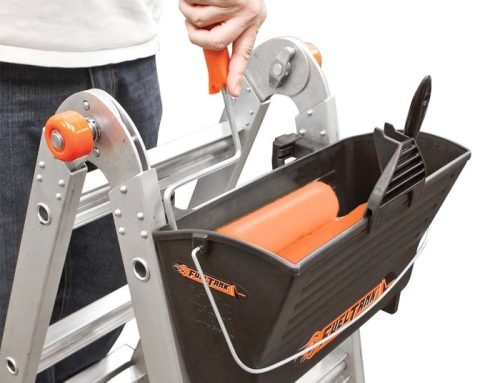People living in flats don't really need an extension ladder – they won't be clearing guttering or the outside of windows, so there is little point in having a long ladder in a small flat where there isn't the space to store it. A stepladder, however, is a must-have for everyone, regardless of whether they live in a flat or a three-storey townhouse. Stepladders are invaluable around the home for reaching tall cupboards, changing light bulbs and redecorating or spring cleaning and they are much safer than using a chair or small table as a substitute.
Stepladders are small and easy to store, even hanging from an over-door hook to make the most of a compact space. In a pinch, a set of kitchen steps can be used as an extra chair when you have guests over and if you only need the ladder for infrequent jobs you can turn it into a piece of interior decoration, perhaps as a plant stand or small bookcase or even somewhere to display trinkets.
A recent episode of Homes Under The Hammer saw a flat which desperately needed an extension ladder, as that is the only way the flat could be accessed. The flat was part of a building which had been used as a fish and chip shop, but the upstairs flat had been left empty as the front door could only be reached from the upper floor. Presenter Martin Roberts was a little stunned by this unusual entry method, as would we be if we'd bought a flat we couldn't just walk in to!
There are two solutions to this problem. The first is to install a staircase inside the property to allow easy access to the flat above, but this would only work if the business owners also wanted to live above the shop. If the flat was intended as a rental property separate to the business premises, an external spiral staircase would be the answer as a space-efficient access route. Fire escape type stairs could also be installed as an alternative private access method to the flat.
Residents in high rise apartment blocks across the country have been investigating fire escape rope ladders and smoke hoods, as a contingency plan should a fire break out in their block. The Grenfell tragedy highlighted the issues of improper cladding and broken or unsuitable sprinkler systems, as well as the response times that some parts of London face when waiting for the fire brigade. A more recent fire at New Providence Wharf prompted residents there, and at other tower blocks, to look into their options for fire safety as they were trapped on balconies by the thick smoke billowing through the inner stairwell.
People living on levels where a standard fire escape rope ladder is too short; have been looking at whether abseiling and climbing equipment would be a suitable fire escape plan. Some of the families are even taking climbing and abseiling courses, so they are prepared in case of emergency. We sincerely hope no-one has to use their escape ladders or abseiling gear, but we have to admire these people for taking their safety into their own hands and investing in life-saving equipment should it be needed.
From this, we know that most residents of flats don't need a ladder for day to day use, although a stepladder should be part of everyone's home. We can also see that there are special circumstances where height access equipment is a vital part of life in an apartment block.






Leave A Comment
You must be logged in to post a comment.